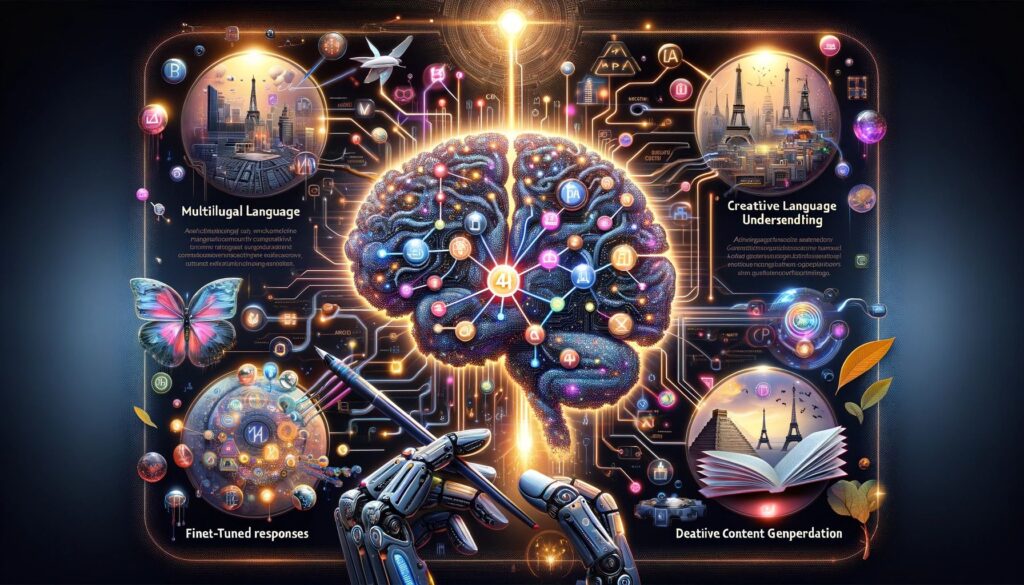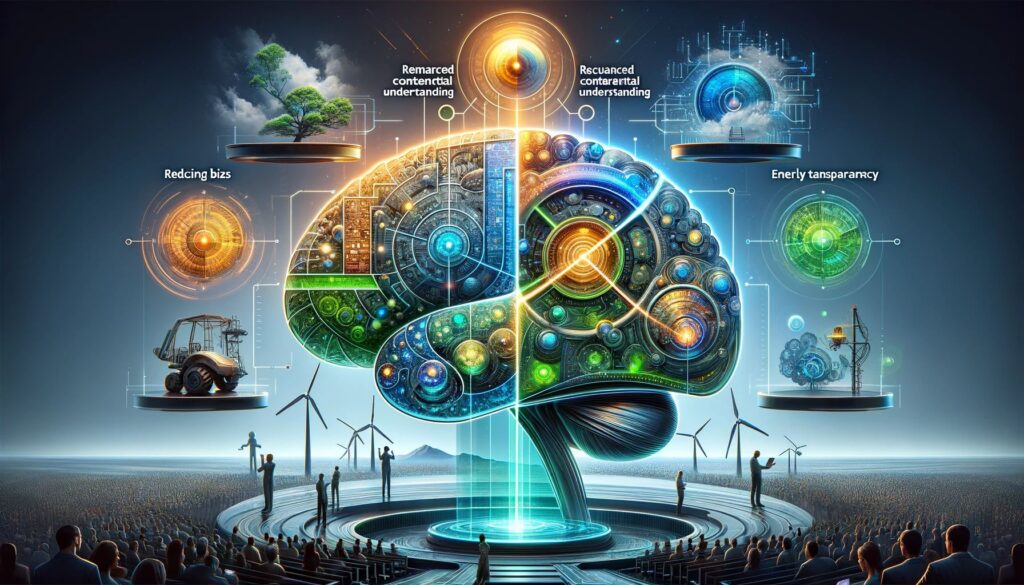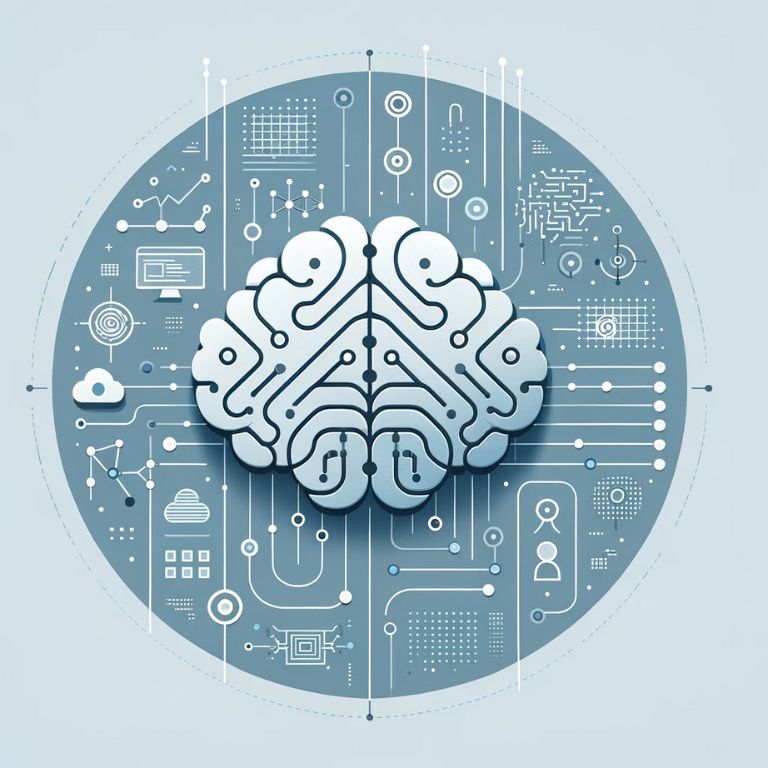In the realm of artificial intelligence, generative models in language processing have emerged as a groundbreaking force, revolutionizing how machines understand and generate human language. These models, at their core, are designed to mimic human language patterns, enabling a wide range of applications from automated text generation to language translation.
The Essence of Generative Language Models
Generative models are a class of AI algorithms used in unsupervised learning. They learn to produce data that is similar to the data they were trained on. In language processing, these models are trained on vast amounts of text data, learning the intricacies of language patterns, grammar, and syntax. This training enables them to generate new text that is coherent, contextually relevant, and often indistinguishable from text written by humans.
How Generative Models Work
At their foundation, generative models in language processing use a combination of neural network architectures, most notably, the Transformer model. This model, first introduced in a 2017 paper by Vaswani et al., marked a significant shift in how machines could handle language tasks. Its ability to process words in relation to all other words in a sentence, rather than sequentially, allowed for a much more nuanced understanding and generation of language.
Key Components:
- Input Layer: Takes in text as input and converts it into numerical form that the model can understand.
- Attention Mechanisms: Allows the model to focus on different parts of the input text to generate more contextually relevant outputs.
- Decoder: Transforms the processed input into meaningful output, such as a continuation of an input text.
From Basic Models to Advanced Systems
The journey from basic generative models to advanced systems like GPT-4 is a tale of continual improvement and innovation. Early models were limited in their understanding and generation capabilities, often producing text that was grammatically incorrect or contextually irrelevant. However, as the models grew in sophistication, particularly with the advent of deep learning and neural networks, their output became increasingly accurate and human-like.
The Role of Big Data
An essential ingredient in the development of these models is data. The training process for generative language models involves feeding them large datasets comprising a diverse range of texts. This exposure to vast and varied language use enables the models to learn and replicate complex language patterns.
Generative models in language processing represent a significant leap in AI’s ability to interact with human language. From simple automated responses to complex conversation and content creation, these models have opened up new frontiers in technology and communication. As we continue to refine and develop these models, their potential to reshape our interaction with the digital world is immense.
The Evolution of Language Models: From Basics to GPT-4
The journey of language models in the field of natural language processing (NLP) is a story of exponential advancement and innovation. This evolution can be best understood by tracing the development of these models from their rudimentary forms to the highly sophisticated GPT-4.
The Early Days: Rule-Based and Statistical Models
Initially, language models were predominantly rule-based, relying on a set of predefined grammatical rules. However, these models were limited in their ability to understand context and nuance.
The next significant advancement came with statistical models. These models, such as Hidden Markov Models (HMMs) and later n-gram models, represented a shift towards probabilistic approaches. They predicted words based on the probability derived from previous words in a sentence, leading to better, though still limited, contextual understanding.
Key Milestones:
- Hidden Markov Models (1980s): Used for basic language tasks, primarily in speech recognition.
- n-gram Models (1990s): Improved text prediction by considering a fixed number (n) of previous words.
The Rise of Machine Learning
The introduction of machine learning models, especially neural networks, marked a transformative phase in language model development. Neural networks could learn language patterns from large datasets, enabling more natural language generation and understanding.
Significant Developments:
- Recurrent Neural Networks (RNNs): Improved handling of sequential data, making them suitable for tasks like speech and text generation.
- Long Short-Term Memory (LSTM) Networks: A type of RNN, LSTMs were better at remembering long-range dependencies in text, enhancing the quality of text generation.
The Breakthrough of Transformer Models
The introduction of the Transformer model in 2017 was a watershed moment. It replaced the sequential processing of RNNs and LSTMs with parallel processing, significantly improving the efficiency and effectiveness of language models.
Transformer Model Characteristics:
- Parallel Processing: Unlike RNNs, Transformers process all words in a sentence simultaneously, leading to faster training and better handling of long-range dependencies.
- Attention Mechanisms: This feature allows the model to weigh the importance of different words in a sentence, improving context understanding.
The GPT Series: A Leap Forward
OpenAI’s GPT (Generative Pretrained Transformer) series has been at the forefront of this evolution. Each iteration brought substantial improvements in language understanding and generation capabilities.
GPT Evolution Timeline:
- GPT (2018): The first in the series, introducing the concept of fine-tuning a pretrained model for various language tasks.
- GPT-2 (2019): Marked a significant improvement in text generation, with a 10x increase in parameters compared to GPT.
- GPT-3 (2020): A massive leap, with 175 billion parameters, enabling more sophisticated and nuanced language generation.
- GPT-4 (2023): The latest iteration, pushing the boundaries further in terms of scale, complexity, and capabilities.
The evolution of language models from basic rule-based systems to advanced entities like GPT-4 illustrates the rapid progress in the field of NLP. Each advancement has brought us closer to achieving human-like understanding and generation of language, opening up unprecedented possibilities in AI applications.
Understanding GPT-4: Capabilities and Technical Breakthroughs
GPT-4, the latest iteration in the Generative Pretrained Transformer series by OpenAI, represents a pinnacle in the evolution of language models. This section delves into the capabilities and technical innovations of GPT-4, illustrating why it’s a landmark in natural language processing.
Architectural Overview of GPT-4
GPT-4, like its predecessors, is based on the Transformer architecture, but with significant enhancements in scale and sophistication. It utilizes a neural network with an unprecedented number of parameters, allowing it to process and generate language with remarkable nuance and complexity.
Key Features:
- Number of Parameters: GPT-4 boasts an astounding number of parameters, significantly more than GPT-3, enabling it to capture finer nuances in language.
- Improved Training Algorithms: Enhanced algorithms allow GPT-4 to learn more efficiently from a diverse range of text data.
- Advanced Context Handling: GPT-4 can maintain context over longer stretches of text, providing more coherent and relevant responses.
Breakthrough Capabilities of GPT-4

GPT-4’s capabilities mark a significant leap from previous models. These capabilities are not just quantitative improvements but qualitative ones, bringing the model closer to a nuanced understanding of human language.
Major Capabilities:
- Enhanced Language Understanding: GPT-4 shows a deeper comprehension of context, idioms, and subtleties in language.
- Multilingual Proficiency: It exhibits improved proficiency in multiple languages, making it more versatile in global applications.
- Creative Content Generation: GPT-4 can generate creative and original content, from poetry to code, with a higher degree of sophistication.
- Fine-Tuned Responses: The model can provide more accurate and contextually appropriate responses in conversational AI.
Technical Innovations Behind GPT-4
GPT-4’s advancement isn’t just about its size but also the innovations in its training and operational mechanisms.
Innovations:
- Sparse Data Handling: GPT-4 can generate high-quality output even from sparse or limited data inputs.
- Efficient Memory Utilization: Despite its size, GPT-4 uses memory more efficiently, allowing for better performance without proportionate increases in computational demands.
- Robustness to Adversarial Inputs: Improved ability to handle and respond to adversarial inputs, making it more resilient in real-world applications.
Limitations and Ethical Considerations
Despite its advancements, GPT-4 is not without limitations. It still faces challenges in consistently understanding highly nuanced or context-specific language and can inadvertently generate biased or incorrect information. Addressing these limitations remains a crucial area of ongoing research and development.
GPT-4 is a testament to the remarkable progress in generative language models. Its capabilities and technical breakthroughs not only enhance the efficiency and effectiveness of language processing tasks but also open new avenues for AI applications, from advanced conversational agents to creative content generation. As we continue to explore its potentials and limitations, GPT-4 stands as a monumental achievement in the journey of AI language models.
Real-World Applications of Generative Language Models
The emergence of advanced generative language models like GPT-4 has not only been a significant academic and technological achievement but also a catalyst for practical applications across various domains. This section explores the diverse real-world applications of these models, highlighting how they are transforming industries and everyday life.
Content Creation and Digital Media
Generative language models have become invaluable tools in content creation, offering assistance in writing articles, scripts, and even books. They can generate creative and engaging content, reducing the time and effort required for brainstorming and drafting.
Applications in Content Creation:
- Automated Journalism: Generating news articles and reports, especially for data-driven stories.
- Creative Writing: Assisting authors in generating ideas, plot points, or even entire sections of text.
- Marketing Copy: Creating compelling marketing and advertising copy tailored to specific audiences.
Customer Service and Conversational Agents
The deployment of GPT-4 in customer service has revolutionized how businesses interact with their customers. AI-driven chatbots and virtual assistants can now provide more nuanced and contextually appropriate responses, enhancing customer experience.
Use in Customer Service:
- Chatbots: Offering more intelligent and human-like interactions in customer service inquiries.
- Virtual Assistants: Providing personalized assistance and support in various tasks, from scheduling to information retrieval.
Education and Learning
In education, generative language models are being used to create personalized learning experiences. They can generate educational content, assist in language learning, and even help in answering student queries.
Educational Applications:
- Personalized Learning Materials: Generating customized learning content based on individual student needs and learning styles.
- Language Learning Tools: Assisting in language learning by providing practice conversations and correcting language use.
Programming and Code Generation

GPT-4 has shown remarkable capabilities in generating and understanding code, making it a valuable tool for programmers and developers.
Programming Applications:
- Code Generation: Assisting developers by generating code snippets or suggesting code improvements.
- Debugging and Error Correction: Identifying errors in code and suggesting corrections.
Healthcare
In healthcare, generative models are beginning to assist in areas like medical research, patient communication, and data analysis.
Healthcare Uses:
- Medical Research: Summarizing and generating insights from medical literature and research papers.
- Patient Interaction Tools: Assisting in patient communication by providing information or answering queries.
Limitations and Ethical Considerations
While the applications are numerous and impactful, it’s important to approach the use of generative language models with caution. Issues like data privacy, ethical use of AI, and the potential for generating misleading information need to be carefully managed.
The real-world applications of generative language models like GPT-4 are extensive and growing. These models are not just academic curiosities but powerful tools that are reshaping industries, enhancing productivity, and changing the way we interact with technology. As we continue to explore and expand these applications, the potential for positive impact is immense, provided we navigate the accompanying challenges responsibly.
Navigating the Limitations and Challenges
While generative language models like GPT-4 have ushered in a new era of possibilities in various fields, they are not without their limitations and challenges. This section critically examines these aspects, providing a balanced view of the current state of generative language technology.
Understanding the Limitations
Despite their advanced capabilities, generative language models still face several significant limitations that impact their reliability and applicability in certain contexts.
Key Limitations:
- Contextual Understanding: While models like GPT-4 have improved context handling, they can still struggle with very complex or nuanced contexts, leading to irrelevant or incorrect outputs.
- Bias and Fairness: These models can inadvertently generate biased content, as they learn from datasets that may contain biased language or viewpoints.
- Dependence on Data Quality: The quality of output is heavily dependent on the quality of training data. Poor or limited data can lead to suboptimal performance.
- Generalization vs. Specialization: Generative models are generally trained to handle a wide range of topics, which can sometimes be a disadvantage in specialized fields requiring deep, specific knowledge.
Technical Challenges
Alongside these limitations, there are technical challenges that come with developing and deploying these models.
Technical Challenges:
- Computational Resources: Training and running models as large as GPT-4 require significant computational resources, making them less accessible for smaller organizations or individuals.
- Model Interpretability: Understanding how these models arrive at certain conclusions or outputs remains a challenge, raising questions about their transparency and trustworthiness.
Ethical and Societal Concerns
The advancement of AI language models raises several ethical and societal concerns that need careful consideration.
Ethical Concerns:
- Misinformation and Manipulation: The potential for these models to generate convincing but false or misleading content is a significant concern, especially in the context of fake news and misinformation.
- Privacy: As these models often require large amounts of data, including potentially personal data, there are concerns regarding user privacy and data security.
- Job Displacement: The automation capabilities of these models raise concerns about job displacement in fields like customer service, content creation, and even programming.
Mitigating the Challenges
To address these challenges, ongoing efforts in AI research and policy are focusing on developing more robust, fair, and transparent models, as well as establishing ethical guidelines for AI development and usage.
Mitigation Strategies:
- Diversifying Training Data: To combat bias, it’s essential to use diverse and inclusive datasets for training these models.
- Developing Explainable AI: Efforts are being made to make AI decisions more transparent and understandable to humans.
- Establishing Ethical Guidelines: Developing and adhering to ethical guidelines to govern the development and use of AI technologies.
Generative language models represent a significant technological advancement, but they come with a set of limitations and challenges that cannot be overlooked. Addressing these issues is crucial for the responsible development and deployment of these technologies. By acknowledging and actively working on these challenges, we can harness the full potential of AI in a way that is beneficial and ethical.
The Future of Generative Models: What Lies Ahead
As we stand at the forefront of advancements in generative language models like GPT-4, it’s both fascinating and crucial to speculate about the future of these technologies. This section explores the potential future developments, emerging trends, and the broader implications they might have.
Predicted Advancements in Technology

The field of generative language models is ripe for continued innovation and development. Future advancements are likely to focus on overcoming current limitations and opening new possibilities.
Future Developments:
- Enhanced Contextual Understanding: Future models are expected to achieve a deeper understanding of context, making them more reliable in complex conversation scenarios.
- Reducing Bias: There will be a significant focus on creating models that are more neutral and unbiased, ensuring fairer and more ethical AI.
- Energy-Efficient Models: As concerns about the environmental impact of large-scale AI grow, developing more energy-efficient models will be a priority.
- Greater Model Transparency: Efforts will likely increase to make AI decision-making processes more transparent and understandable.
Emerging Trends
Several trends are emerging in the field of generative language models, indicating the direction in which the technology is headed.
Key Trends:
- AI Collaboration Tools: The development of tools that enhance and augment human capabilities, rather than replace them, is a growing trend.
- Cross-Disciplinary Applications: The integration of language models with other AI domains, like computer vision and robotics, to create more sophisticated AI systems.
- Personalization: The use of AI to provide highly personalized experiences, from customized learning programs to personalized healthcare advice.
Potential Improvements and Innovations
The quest for improvement and innovation in AI is endless. Future models may not only be more advanced in their core capabilities but also bring entirely new functionalities.
Innovations to Look Forward To:
- Multimodal AI: The convergence of text, image, and voice processing in a single model, enabling more comprehensive AI systems.
- Interactive Learning: Models that can learn interactively in real-time, adapting to new information or user feedback instantly.
- Autonomous AI Agents: The development of AI agents capable of performing complex tasks independently, with minimal human intervention.
Ethical and Societal Implications
As these models evolve, they will continue to raise important ethical and societal questions. Navigating these implications responsibly will be crucial.
Considerations for the Future:
- Governance and Regulation: Establishing global standards and regulations for AI development and use.
- Balancing Innovation and Responsibility: Striking a balance between pushing the boundaries of AI and ensuring responsible and ethical use.
The future of generative models in language processing is one of vast potential and significant responsibility. As we continue to innovate, the focus must remain on creating technologies that benefit society as a whole, addressing challenges, and embracing opportunities responsibly. The journey ahead is as exciting as it is crucial, with the promise of AI transforming our world in ways we are just beginning to imagine.
The Impact of Generative Language Models on Society
Generative language models like GPT-4 are transforming human-computer interaction, breaking language barriers, and making information more accessible. They augment creativity and efficiency in various fields, offer personalized education, and prompt ethical AI discussions. However, balancing innovation with ethics is crucial to ensure societal benefits. The future of these models is promising but requires continuous research and ethical alignment to enhance human capabilities positively.




